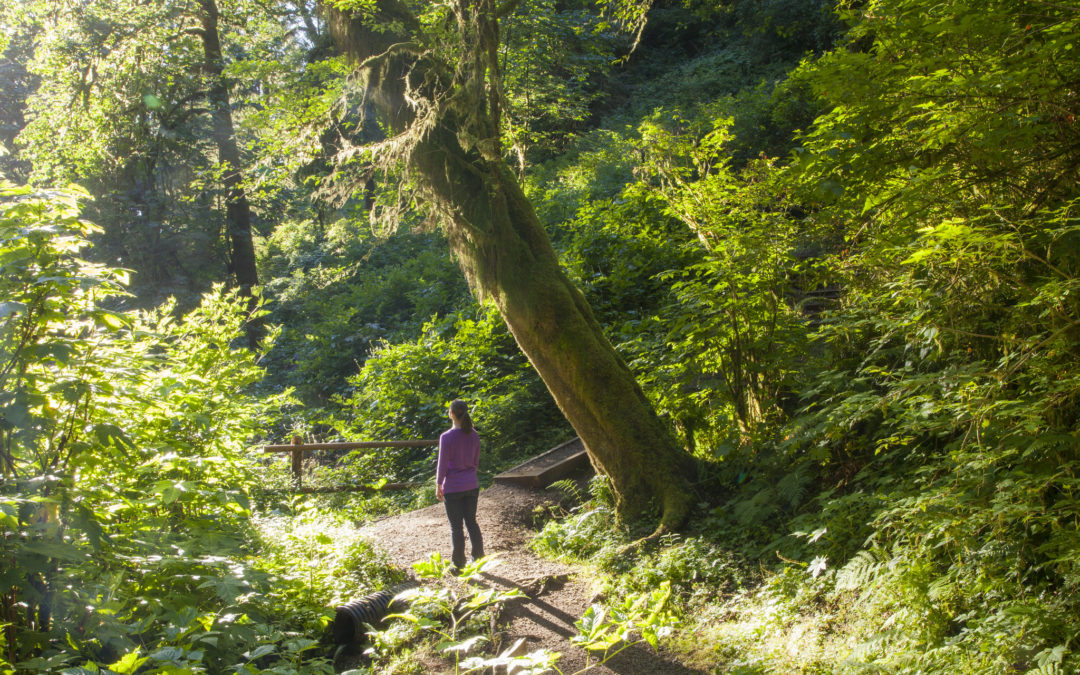Tillamook County is a wonderland of beautiful trails within an easy drive, giving everyone the chance to breathe the fresh air, walk off stress, and experience something new right here in our own backyard.
Worried that you won’t know how to hike the right way? In the hiking community there is a saying; Hike Your Own Hike. It means that there are a million ways to hike and the only “right way” is the right way for you. Power walkers and the “sloth team,” over-packers and minimalists, booted stompers and sneaker-wearing wanderers, all are welcome. Take your time, find the method that works for you, and do what makes you happy.
Here are a few guidelines that will help make your first hike a great experience.
The Ten Essentials
The Ten Essentials are the 10 things you should bring with you on every hike. Yes, every hike, even when it’s only half a mile. All of this should fit in a small backpack and don’t be afraid to dig out that old school bag.
- Good Shoes: Happy feet make for happy hikers. Pick shoes that fit well, have good treads for traction in mud, and will protect your feet from rocks, roots, and everything else. Worn in jogging shoes are usually a good choice for beginners. Wear wool or synthetic socks rather than cotton to prevent blisters.
- Map and GPS: You probably rely on your phone for directions, but it won’t necessarily work in the woods. Download a map to use offline, print out a hard copy map, and maybe even break out that old compass just in case.
- Water: There’s nothing like a cool gulp of water on a hot day. Bring a 16oz bottle of water for every person for every hour of hiking. Fill up a reusable bottle (usually 32oz) to save space and money. Bring extra water if it’s hot, the trail is steep, or if you’re bringing your thirsty dog.
- Food: Hikers need snacks! Your body will want more energy during your hike and kids especially need snacks. Choose something healthy like fruit, vegetables, whole grain crackers, nuts, and trail mix. High-protein energy bars can be a good choice.
- Rain Gear and Extra Layers: This is the Pacific Northwest, after all. Rain, fog, cold winds, and cool nights are normal. By layering a t-shirt under a sweatshirt you can take off a layer if you get overheated and then put it back on if it cools down. A rain jacket can also be a wind break and bringing a sweatshirt and a warm hat can help you be ready for whatever our wild weather can throw at us.
- Safety Items: Bring a light, a fire-starting kit, and a whistle. You can buy little “emergency prep” kits in most gas stations. These are just-in-case items, but you’ll be glad to have them if you need them. Kids should each have a whistle and know to blow 3 short blasts if they need to “find Mom and Dad.”
- First Aid Kit: Blisters, scrapes, or twisted ankles, a good First Aid Kit can take care of the problem. These kits are available in pharmacies in several sizes. Open up the kit and make sure you know what’s inside and how to use it to help. Think about if your family has any specific needs and add things if necessary.
- Knife or Multi-Tool: A simple pocketknife is a good thing to have and a multi-tool can be useful in many situations. From opening a snack packet to emergency fire starting, you’ll be glad you have it when you need it.
- Sun Protection: The sun is a welcome visitor to the Oregon coast, but we all know how harsh it can be. A hat, sunglasses, and sunscreen will help you enjoy the sun, rather than getting burned.
- Shelter: Many First Aid Kits will have a space blanket; light, inexpensive, and a great option for an emergency.
If your bag is packed with the Ten Essentials, then consider yourself ready for an easy trial run. Choose a well-known trail that’s close to town, short, and easy for your first hike. Let someone know where you’re going and when you’ll be back. Test yourself by pretending to be in the wilderness and imagine how you would deal with rain, getting lost, or a minor injury. Finally, make sure to have fun! It’s more important to enjoy yourself than it is to finish the trail, follow a specific plan, or reach your destination. Hike Your Own Hike, and you may find yourself planning your next trail as soon as you get home.
AUTHOR: Samantha Goodwin, NW Youth Corps, GIS Intern, US Forest Service

